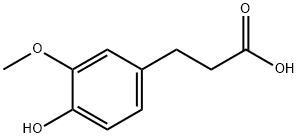1135-23-5
 1135-23-5 結(jié)構(gòu)式
1135-23-5 結(jié)構(gòu)式
基本信息
3-(4-羥基甲基)丙酸
氫化阿魏酸
3-(4-羥基-3-甲氧基苯基)丙酸
3-(4-HYDROXY-3-METHOXYPHENYL)PROPANOIC ACID
3-(4-HYDROXY-3-METHOXYPHENYL)PROPIONIC ACID
3-(4-HYDROXYMETHYL)PROPIONIC ACID
3-METHOXY-4-HYDROXYHYDROCINNAMIC ACID
4-HYDROXY-3-METHOXYHYDROCINNAMIC ACID
BETA-(4-HYDROXY-3-METHOXYPHENYL)PROPIONIC ACID
HYDROFERULIC ACID
Benzenepropanoic acid, 4-hydroxy-3-methoxy-
3-(4-HYDROXY-3-METHOXYPHENYL)PROPIONIC
HYDROFERULIC ACID(RG)
3-(4-HYDROXY-3-METHOXYPHENYL)PROPIONIC ACID 98%
3-Methoxy-4-hydroxybenzenepropanoic acid
3-Methoxy-4-hydroxybenzenepropionic acid
4-Hydroxy-3-methoxybenzenepropanoic acid
物理化學(xué)性質(zhì)
安全數(shù)據(jù)
| 報(bào)價(jià)日期 | 產(chǎn)品編號(hào) | 產(chǎn)品名稱(chēng) | CAS號(hào) | 包裝 | 價(jià)格 |
| 2025/02/05 | A12069 | 3-(4-羥基-3-甲氧基苯基)丙酸, 97% 3-(4-Hydroxy-3-methoxyphenyl)propionic acid, 97% | 1135-23-5 | 1g | 664元 |
| 2025/02/05 | A12069 | 3-(4-羥基-3-甲氧基苯基)丙酸, 97% 3-(4-Hydroxy-3-methoxyphenyl)propionic acid, 97% | 1135-23-5 | 5g | 2558元 |
| 2025/02/05 | H1180 | 3-(4-羥基-3-甲氧苯基)丙酸 3-(4-Hydroxy-3-methoxyphenyl)propionic Acid | 1135-23-5 | 1G | 350元 |
常見(jiàn)問(wèn)題列表
Uptake of hydroxycinnamic acids by control, organic anion transporter 1 (OAT1), OAT2, OAT3, and OAT4 over expressing 293H cells. In 293H control cells, there was significant uptake of Dihydroferulic acid. The uptake of Dihydroferulic acid is also enhanced ~2-fold in the OAT1-expressing cells.
Assessing the influence of an 11 weeks intervention with a resistant starch-enriched whole grain diet (HI-RS-WG, 25% RS) compared to a WG control diet (LOW-RS-WG, 6.9% RS) on serum profile of polyphenols (PPs) in 20 Zucker Diabetic Fatty rats. Five PPs were identified and quantified in serum samples of rats belonging to both intervention groups. HI-RS-WG rats had 2.6 folds higher serum concentrations of total PPs than LOW-RS-WG rats. An explorative data reduction approach, based on the Principal Component Analysis identified two principal components related to the gut microbiota fermentation and food intake, respectively. Results showed that the abundance of hippuric acid and Dihydroferulic acid in HI-RS-WG rats was explained by the stronger gut microbiota fermentation in those rats than in LOW-RS-WG rats.
